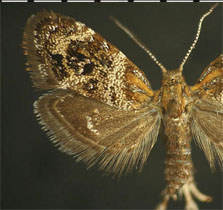
The larva of Tebenna silphiella (Fig. 1) feeds as a leaf skeletonizer on rosinweed, Silphium integrifolium (Asteraceae), almost always on the top leaves (those at or near the apex) of the plant. In central Illinois, there are two generations, larvae of which occur in early and late May, respectively. The large Tebenna spp., including T. silphiella, represent an array in which species delineations appear to be unresolved. In Illinois, moths reared from rigid goldenrod, Solidago rigida (Asteraceae) and from Eupatorium, species not denoted (Asteraceae), are identical in color, pattern, and genital morphology to T. silphiella reared from rosinweed (and also to specimens identified as Tebenna carduiella in the collection of the Illinois Natural History Survey).

Figure 1. Tebenna silphiella. Adult; leaf skeletonization on rosinweed, Silphium integrifolium (Asteraceae); partially grown larva; and cocoon.
Tebenna gnaphaliella (Fig. 2) feeds as a larva on cudweed, Gnaphalium sp. (Asteraceae). The adult is nearly identical in color and pattern to T. silphiella but is much smaller. Apparent differences in genital morphology suggest that T. gnaphaliella actually is a separate species from, and not merely a "miniature" host race of, T. silphiella. Adults of T. gnaphaliella have been collected in Illinois in the summer months through early September; this suggests that there are at least two generations per year.
